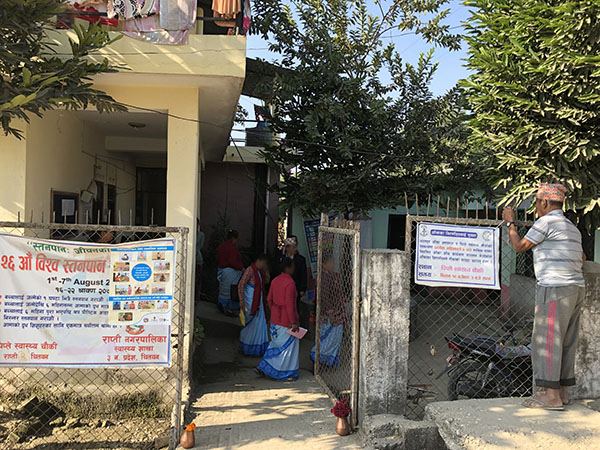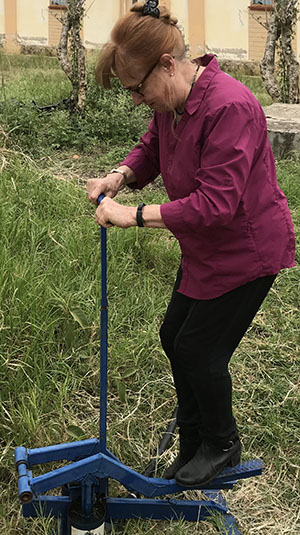Around the World and Back Again: Global Mental Health Efforts
By
Mental illnesses are a global problem and among the most common causes of disability, placing a heavy burden on individuals, families, and societies alike. Accordingly, mental health research must seek global solutions.
Over the past decade, the National Institute of Mental Health (NIMH) has reinvigorated its global mental health research portfolio. NIMH is encouraging ambitious, collaborative projects to bring cutting-edge research to bear on the problems facing individuals with mental illnesses in low-resource settings. These projects are designed for rapid public health impact, both locally where they are carried out, as well as here in the United States, where lessons learned can be applied to underserved populations. I recently had the opportunity to see NIMH-funded research projects first-hand in Nepal and Kenya, meeting with researchers as well as service users and public health officials. These visits affected me deeply, and I thought I should share them with you.
Engaging community health care workers in the mental health mission: Bharatpur, Nepal
I stepped out of the van on a warm and dusty morning, a bit bewildered after being driven the short distance to the Kathmandu airport from my hotel through a twisting maze of traffic with lots of tooting horns. Boarding a small plane with me were Brandon Kohrt, M.D., Ph.D., Associate Professor at George Washington University and principal investigator of the NIMH-funded research (MH111280 ; MH104310 ) I was there to learn about, and Nagendra Prasad Luitel, M.A., the head of research for the Transcultural Psychosocial Organization Nepal (TPO) . TPO, Dr. Kohrt’s principal collaborator on the project, has been pioneering the implementation of mental health care in Nepal for more than 15 years.
We landed a half-hour later at a small airport in Bharatpur, a city in the high plains near the border with India, and were met by other members of Dr. Kohrt’s team for the drive across town and through a forested national park to a community health clinic in an outlying town. The entire clinic staff lined up to greet us — a dozen or so nurses and community health care workers, plus the district health commissioner and several clients. The warm welcome, which involved each of the staff draping garlands of marigolds around our necks, was followed by introductions and statements of thanks.
I was in Bharatpur to see first-hand the work done by Dr. Kohrt’s team to address the vexing problem of how to deliver mental health care in settings where there aren’t enough care providers. There are fewer than 150 psychiatrists in all of Nepal to serve a population of nearly 30 million people. The vast majority of these psychiatrists are in Kathmandu, an 8-hour drive from the clinic I was visiting. There are even fewer psychologists and social workers. The clinic has nurses and the equivalent of a physician’s assistant, but no physician or mental health professionals.
To address the lack of trained mental health care providers, the WHO has developed a program to teach community health care workers the basics of mental health care. Through this program, called mhGAP , they learn to recognize depression, psychosis, anxiety, and a handful of other neuropsychiatric conditions, and to apply basic, evidence-based treatments such as antidepressants or abbreviated forms of cognitive behavioral therapy. mhGAP has been rolled out in several lower- and middle-income countries with some success. A limiting factor in its success, however, has been uptake by the health care workers, who may have difficulty understanding the need for and impact of these treatments for mental illnesses. Engaging these workers to proactively assess for and manage mental illnesses is an unmet gap.

Dr. Kohrt’s NIMH-funded research project (MH104310 ) is exploring whether the engagement gap can be bridged with the help of service users themselves. Dr. Khort’s research team trains individuals with mental illnesses who have received treatment from these community clinics to tell their stories in clear, concise, and compelling narratives.
I heard three of these courageous self-advocates describe how their illnesses affected their lives and how the treatments administered by community health workers transformed their ability to function. One of them, a young man with schizophrenia, was perhaps the most compelling. He described his tumultuous life before receiving care as being trapped in a paranoid nightmare in which he constantly argued with his family, ran away from home, hid from those who cared for him, and was unable to contribute to his own sustenance, much less that of his family. He was finally convinced to come to a community health center for evaluation and was prescribed antipsychotic medication. Within weeks, he was feeling better, and now, nearly a year later, his symptoms are fully under control. He has re-integrated with his family and is working for a local business and feeling happy to be able to contribute to his family’s welfare.
As I sat in the small clinic’s conference room, listening to this man tell his story, I looked around the room at the colorfully dressed clinic staff, at the marigolds draped around the necks of the TPO researchers, and at the chalkboard tally of patients evaluated and treated for mental illnesses at the clinic. Here was concrete proof of the immediate impact of our global mental health research portfolio.
At the intersection of mental health and HIV care: Kisumu and Eldoret, Kenya
There were about ten of us in the van, bouncing down a rutted road of dust and rock outside of Kisumu, Kenya, dodging trucks overloaded with sugar cane on their way to the refinery we had just passed. Turning right into one of the many small farms that lined the road, we hopped out and assembled under a beautifully blooming Nandi Flame tree to meet two farmers participating in an innovative research project called Shamba Maisha . This project (MH094215; MH107330; MH095683; HD095739 ) is part of a global HIV research portfolio, which studies behavioral approaches to increase adherence to and acceptability of interventions aimed at stopping the HIV epidemic.

pedal-powered irrigation pump.
Shamba Maisha is a collaboration between the University of California, San Francisco (UCSF), the Kenya Medical Research Institute (KEMRI), KickStart International, and the Equity Bank. Shamba Maisha means “Farm to Live,” and the program is about exactly that: improving the productivity of small farms in Western Kenya to improve health in those living with HIV and their families. The project lends farmers money to purchase irrigation tools and teaches them sustainable farming techniques and simple marketing and accounting methods.
Dianne Rausch, Ph.D., the director of NIMH’s Division of AIDS Research, and I visited the farm with Craig Cohen, M.D., M.P.H. and Sheri Weiser, M.D., M.P.H., M.A., UCSF Professors and principal investigators, and other project scientists from UCSF and KEMRI. We watched as the farmers demonstrated how they irrigate their small farms quickly and easily with a pump that looks like a low-tech stair climbing machine. They described the difference the program has made for them and their families, how they decide which vegetables to plant, which they like to eat themselves, and where and for how much they sell the surplus. They eat and feel healthier, and they have money to contribute to their families’ welfare. Then the UCSF and KEMRI scientists chimed in, telling us that the intervention saves lives and contributes to efforts to control the HIV epidemic. Participants in the program miss fewer clinic visits since they can more easily afford the time and money it takes to get to the clinics. They are more adherent to their medication regimens, have lower viral loads, and are sick less often. At that point, one of the farmers interjected, “I haven’t been to the hospital since I started Shamba Maisha.”
The next day we drove up and over the hills separating Kisumu from the rift valley towards the city of Eldoret, Kenya. Dust gave way to verdant hillsides as sugar cane farms were replaced by tea plantations. Our destination was a clinic in Mosoriot, Kenya. The Mosoriot Clinic is famous in Kenya, thanks mostly to the effort of Joseph Mamlin, M.D., Professor Emeritus at Indiana University. Dr. Mamlin has worked in Mosoriot for more than 30 years and was the first physician to treat a patient with HIV in Kenya with antiretroviral drugs. Now the Mosoriot Clinic cares for more than 15,000 patients with HIV.
Working with colleagues in Kenya and the United States, Dr. Mamlin co-founded Ampath . Ampath combines a care-driven mission with cutting-edge research, all in the name of improving care for individuals with HIV in Western Kenya. A consortium of universities in the U.S., led by Indiana University, works with Moi University and the Moi Teaching and Referral Hospital in Eldoret to conduct research in a true learning health care system run by Ampath, comprising more than 500 clinics.
At the Mosoriot Clinic, we learned about a number of research projects aimed squarely at the HIV epidemic, including efforts to improve adherence to medication in adolescents with HIV using peer advisors and group therapy; programs aimed at providing low- and no-cost drugs through cooperative pharmacies; and efforts to examine the efficacy of interventions targeting depression and trauma to improve control of HIV infection as well as mental health symptoms. Each of these projects involved collaborations between U.S.- and Kenya-based researchers, providing opportunities to enhance the capacity for research in Kenya while providing answers to crucial research questions with global impact.
Bringing it home
This global impact touches us here in the U.S. as well. Lessons learned in Nepal, Kenya, and elsewhere can impact how we think about care delivery in the U.S. Already, NIMH research projects are testing how to implement peer advisors to reach more adolescents with HIV and/or mental illnesses; exploring how to recruit non-specialist health providers to deliver mental health care in underserved settings where psychiatrists and therapists are rare; and determining the impact of effectively treating depression, post-traumatic stress disorder, and other mental illnesses on the quality and effectiveness of general health care. Through cutting-edge research around the world, global efforts yield truly global impacts.

